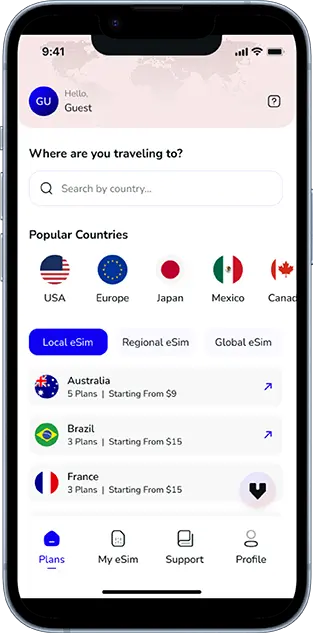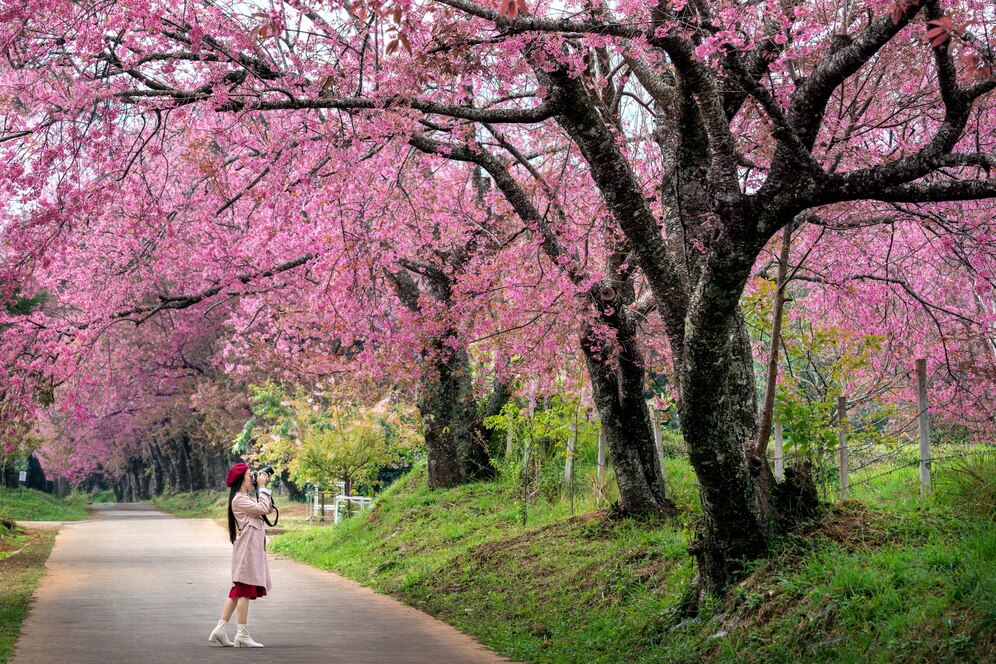Note that iPhone devices from Mainland China aren’t eSIM compatible. Also iPhone devices from Hong Kong and Macao aren’t compatible (except for iPhone 13 Mini, iPhone 12 Mini, iPhone SE 2020 and iPhone XS)
Spring in Japan is an iconic season, especially when the cherry blossoms (sakura) bloom. These beautiful flowers symbolize the transient nature of life and are deeply ingrained in Japanese culture. Whether you’re an avid traveler or someone simply looking for an unforgettable experience, witnessing the cherry blossoms in Japan is something you must not miss. In this guide, we’ll walk you through the best time to visit and the top spots to enjoy Japan’s sakura in full bloom.
Why Cherry Blossoms Are a National Symbol
Cherry blossoms, or sakura, have been intertwined with Japan’s identity for centuries. These delicate pink flowers are more than just a seasonal bloom—they’re an emblem of the country itself. Sakura is often referred to as Japan’s unofficial national flower, symbolizing renewal, fleeting beauty, and the impermanence of life. This concept, known as “mono no aware,” is deeply rooted in Japanese culture and reflects the bittersweet beauty of life’s transience. During spring, the entire nation comes alive with cherry blossom festivals, celebrating not just nature but also this cultural philosophy.
The Cultural Significance of Hanami
Hanami, or flower viewing, is a cherished tradition in Japan that dates back over a thousand years. Originally practiced by the imperial court, it eventually became a pastime for everyone. Today, families, friends, and colleagues gather under blooming cherry trees for picnics, laughter, and shared memories. The atmosphere during these gatherings is vibrant, yet tranquil—a perfect reflection of the sakura itself. Many spring festivals in Japan center around hanami, offering a chance to enjoy traditional music, dance, and sakura-themed treats.
How Sakura Reflects the Spirit of Spring
Spring in Japan wouldn’t feel complete without the arrival of cherry blossoms. They mark a time of fresh beginnings, as both the school and fiscal years start in April. Shops fill their shelves with sakura-themed products, from sweets to decorations, and the air buzzes with excitement. The blossoms also inspire countless forms of art, from poetry to paintings, capturing their fleeting beauty. Just like the season itself, sakura reminds people to embrace change and appreciate the present moment. Whether you’re attending a cherry blossom festival in Japan or simply walking under a canopy of blooms, the spirit of spring feels undeniably alive.
When to Visit Japan for Cherry Blossom Season
Understanding the Sakura Blooming Timeline
Cherry blossoms, or sakura, are one of Japan’s most iconic symbols, but catching them at their peak requires some planning. The blooming period is famously short—typically lasting just one to two weeks. The season starts in the subtropical islands of Okinawa as early as January, while Hokkaido in the north sees blossoms in May. For most of Japan, including popular regions like Tokyo and Kyoto, the prime time falls between late March and early April. However, the exact timing can vary year to year depending on weather conditions, so keeping an eye on the annual sakura forecast is key.
Regional Differences in Blooming Periods
Japan’s geography plays a big role in the timing of cherry blossoms. Here’s a rough breakdown:
- Okinawa (South): Mid-January to early February
- Kyushu and Southern Honshu (Fukuoka, Hiroshima): Late March to early April
- Kansai Region (Osaka, Kyoto): Early April
- Kanto Region (Tokyo, Yokohama): Late March to the first week of April
- Tohoku (Northern Honshu): Mid to late April
- Hokkaido (North): Early to mid-May
This staggered blooming period means you can plan trips to different regions to maximize your chances of seeing the blossoms.
Tips for Timing Your Trip Perfectly
Planning your trip around cherry blossom season can be tricky, but these tips might help:
- Start Planning Early: Hotels and flights fill up quickly during sakura season, especially in major cities like Tokyo and Kyoto. Booking at least 4-6 months in advance is ideal.
- Check the Forecasts: Japan releases detailed cherry blossom forecasts starting in January. These updates track when the blooms are expected to open and peak in each region.
- Be Flexible: Weather can shift the blooming period by a few days, so having some flexibility in your itinerary can help you catch the blossoms at their best.
- Consider Late-Blooming Spots: If you miss the main season, head north to Tohoku or Hokkaido for their later blooms.
- Mix in Festivals: Many areas host cherry blossom festivals, with food stalls, performances, and nighttime illuminations. These events can add an extra layer of charm to your trip.
With careful planning, you can experience the magic of sakura no matter when you visit Japan in spring.
Top Cherry Blossom Viewing Spots in Tokyo
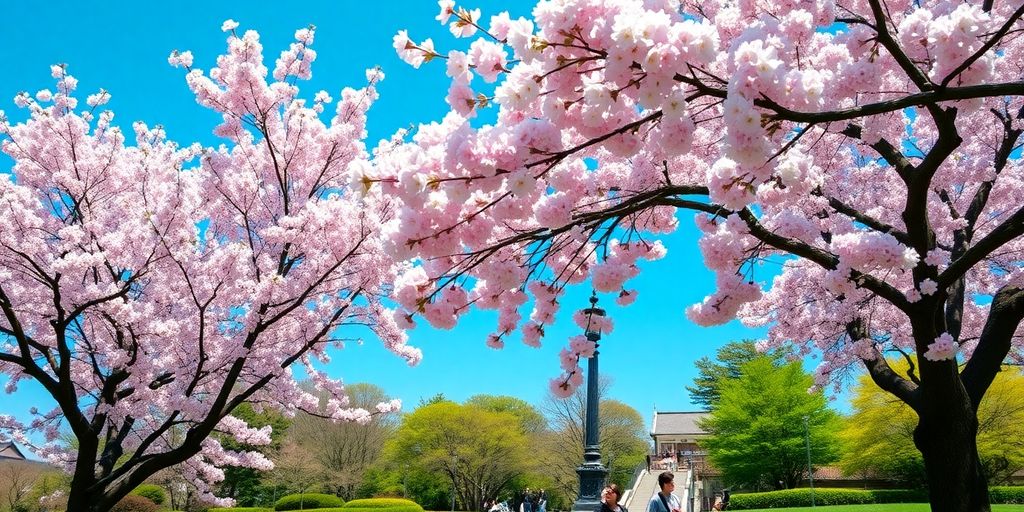
Ueno Park: A Classic Hanami Destination
When it comes to the best places to see cherry blossoms in Tokyo, Ueno Park is a must-visit. With around 1,200 cherry trees lining its pathways, the park becomes a hub of activity during sakura season. Families, friends, and tourists gather here for hanami (cherry blossom viewing) picnics. The atmosphere is lively, and in the evenings, the blossoms are illuminated by traditional lanterns, creating a magical ambiance. Pro tip: Arrive early to secure a good spot, as it gets crowded quickly.
The Enchanting Nakameguro Canal
For a more romantic and picturesque setting, head to the Nakameguro Canal. This charming area features cherry trees arching gracefully over the water, their petals often creating a pink carpet on the surface. The canal is lined with cafes and shops, making it a great spot to enjoy sakura-themed treats while soaking in the view. Evening light-ups add an extra layer of beauty to this already stunning location.
Chidorigafuchi: Blossoms by the Moat
Chidorigafuchi offers one of the most breathtaking cherry blossom experiences in Tokyo. Situated near the Imperial Palace, this spot features a moat surrounded by lush sakura trees. Renting a boat to paddle along the water is a popular activity, allowing you to admire the blossoms from a unique perspective. Whether you visit during the day or at night when the trees are illuminated, Chidorigafuchi is undeniably one of the best places to see cherry blossoms in Tokyo.
Ready for Japan’s spring beauty?
Capture every moment of your Japan adventure with our reliable eSIM plans.
Exploring Kyoto’s Iconic Sakura Locations
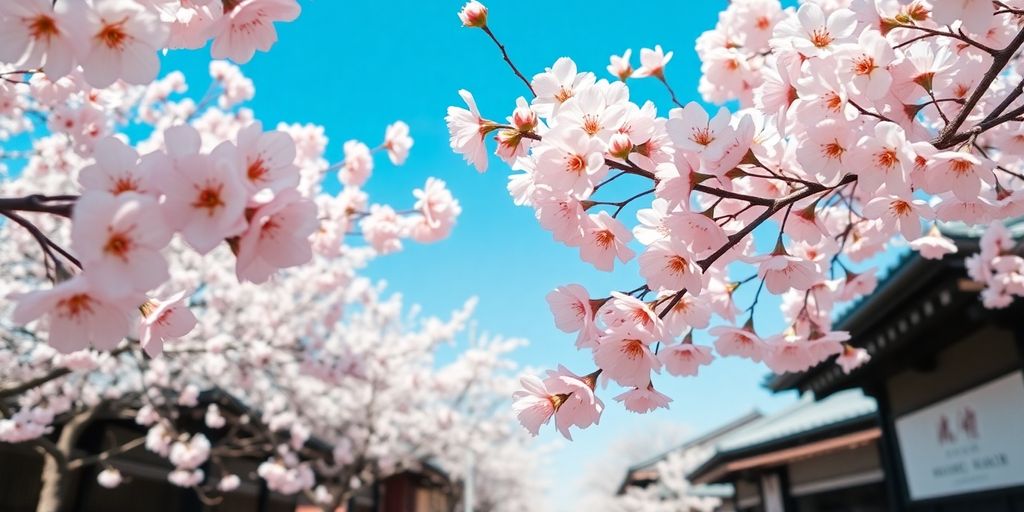
Maruyama Park: Kyoto’s Cherry Blossom Hub
Maruyama Park is the heart of Kyoto’s cherry blossom season. It’s famous for the “Gion Shidare-zakura,” a towering weeping cherry tree that draws visitors from across the globe. This tree isn’t just big—it’s breathtaking. At night, it’s illuminated, making it even more magical. The park itself has over 680 cherry trees, so there’s no shortage of spots to lay down a blanket and enjoy hanami. Pro tip: Arrive early if you want a prime picnic spot, as it gets crowded fast. Afterward, wander to the nearby Shirakawa Canal, which is also lined with cherry blossoms and beautifully lit in the evening.
The Philosopher’s Path in Full Bloom
If you’re after a more tranquil experience, the Philosopher’s Path is the place to be. This stone path follows a canal, and during cherry blossom season, it’s like walking through a dream. The trees form a canopy of pink and white blossoms overhead, and petals often float gently in the water below. It’s a quieter spot compared to Maruyama Park, making it ideal for those who want to soak in the beauty without the crowds. Plus, there are plenty of cozy cafes and small temples along the way if you feel like taking a break.
Kiyomizu-dera Temple’s Sakura Views
Kiyomizu-dera Temple offers one of the most iconic views in Kyoto. Perched on a hillside, the temple’s wooden stage overlooks a sea of cherry blossoms. It’s a sight that’s hard to forget. The combination of the historic architecture and the vibrant sakura blooms is pure Kyoto. If you visit in the evening, the temple often hosts special light-up events, adding an extra layer of charm to the experience. Just be prepared for some uphill walking—it’s worth it, though, for the views alone.
Hidden Cherry Blossom Gems Across Japan
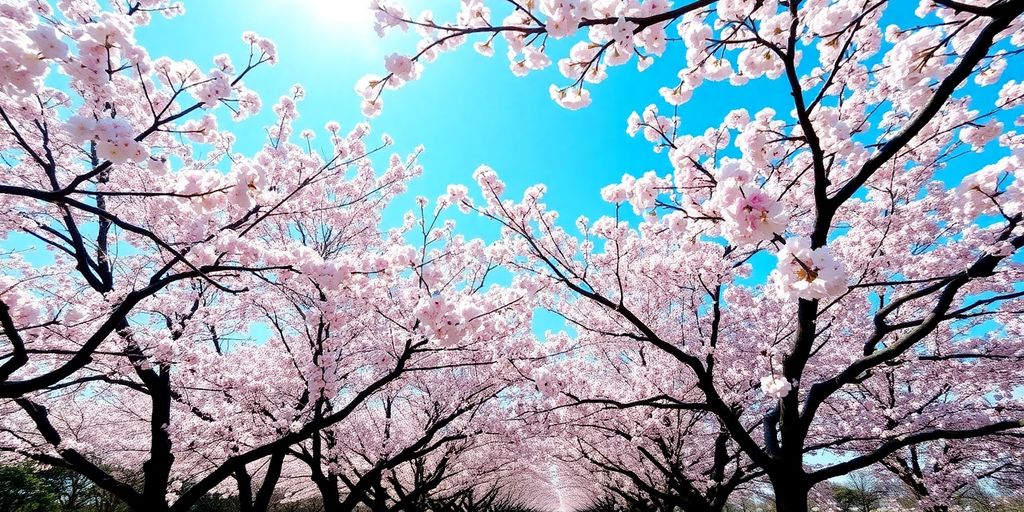
Kawazu: Early Blooms in Izu Peninsula
Kawazu, located on the Izu Peninsula, is famous for its Kawazu-zakura, a cherry blossom variety that blooms earlier than most others in Japan. These vibrant pink flowers start to appear as early as late February, making Kawazu one of the first places in the country to welcome spring. The Kawazu Cherry Blossom Festival is a highlight of the season, drawing visitors with its picturesque riverside lined with over 8,000 cherry trees. Strolling through this tunnel of blossoms is an unforgettable experience, especially when paired with local treats sold at nearby stalls.
Hirosaki Castle: A Northern Treasure
Hirosaki Castle in Aomori Prefecture offers a stunning blend of history and natural beauty. The castle grounds are home to over 2,500 cherry trees, creating a breathtaking scene when they bloom in late April to early May. What sets Hirosaki apart is its “hana-ikada,” or flower rafts—fallen petals floating on the castle’s moat, forming a pink carpet on the water. The annual Hirosaki Cherry Blossom Festival adds to the charm, featuring food stalls, traditional performances, and even nighttime illuminations.
Yoshino: The Pinnacle of Sakura Beauty
Mount Yoshino in Nara Prefecture is often considered the ultimate destination for cherry blossom viewing in Japan. This UNESCO World Heritage Site boasts over 30,000 cherry trees spread across its slopes, creating a layered effect of pink and white blossoms. The trees are divided into four zones—Shimo Senbon (lower), Naka Senbon (middle), Kami Senbon (upper), and Oku Senbon (deep)—allowing visitors to enjoy varying views as they ascend. Yoshino’s beauty has inspired poets and artists for centuries, and it remains a must-visit for anyone seeking a truly magical sakura experience.
Cherry Blossom Festivals You Shouldn’t Miss
Osaka Castle Park’s Illuminated Blossoms
Osaka Castle Park is a breathtaking destination during cherry blossom season. The park features over 3,000 sakura trees, creating a stunning pink and white landscape around the iconic castle. At night, the blossoms are illuminated, offering a magical experience known as “yozakura.” Visitors can enjoy strolling through the park, taking in the reflections of the illuminated blooms against the castle’s moat. Don’t forget to grab a sakura-themed bento box or sip on some sake as you soak up the festive atmosphere.
Hirosaki Cherry Blossom Festival
Located in Aomori Prefecture, Hirosaki Castle is home to one of Japan’s most celebrated cherry blossom festivals. The castle grounds boast over 2,600 cherry trees, and the festival attracts millions of visitors each year. Highlights include picnics under the blossoms, traditional performances, and the unforgettable nighttime light-ups. The castle’s moat is often filled with fallen petals, creating a phenomenon known as the “sakura carpet.” It’s a sight that perfectly captures the fleeting beauty of cherry blossoms.
Seasonal Delights at Fukuoka’s Parks
Fukuoka’s cherry blossom festivals offer a mix of urban and natural beauty. Maizuru Park, with its historic ruins, and Nishi Park, known for its panoramic views, are two must-visit spots. These festivals often feature food stalls serving sakura-inspired treats like sakura mochi and cherry blossom-flavored ice cream. Visitors can also enjoy cultural performances and tea ceremonies, making it a well-rounded experience for all ages.
The Role of Weather in Sakura Blooming
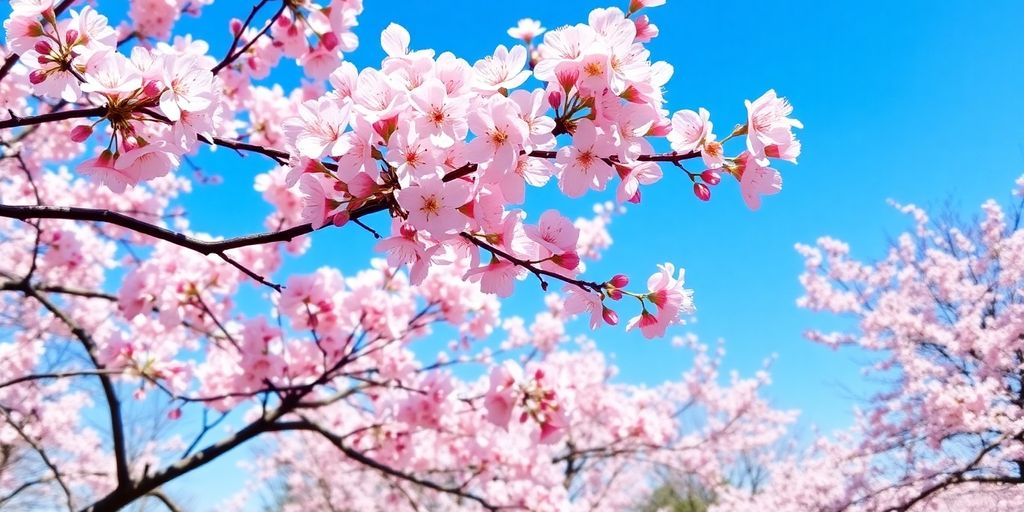
How Climate Affects Blooming Patterns
Cherry blossoms are incredibly sensitive to weather changes, which makes predicting their bloom a fascinating yet complex process. The timing of the sakura bloom is primarily influenced by temperature. Warmer winters can cause the trees to bloom earlier, while colder conditions delay the process. For instance, regions like Tokyo might see blossoms as early as late March during mild years, while northern areas like Hokkaido often wait until late April or even May. Rain and wind also play a role, as heavy rainfall or strong winds can shorten the blooming period, stripping the delicate petals from the branches prematurely.
Tracking the Sakura Zensen (Cherry Blossom Front)
The “sakura zensen,” or cherry blossom front, is a term used to describe the progression of blooming from the southernmost parts of Japan to the northernmost regions. It typically starts in Kyushu in late March and moves northward to Hokkaido by early May. Meteorological agencies in Japan closely monitor this front, providing daily updates during the season. These forecasts are invaluable for travelers planning to catch the blossoms at their peak. The movement of the sakura zensen is influenced by the geography and climate of each region, making it a unique phenomenon to follow.
Using Forecasts to Plan Your Visit
If you’re planning a cherry blossom trip, keeping an eye on weather forecasts is essential. The bloom period usually lasts about two weeks, from the first opening of flowers to full bloom. However, this can vary depending on local weather conditions. To maximize your chances of seeing sakura in their full glory, consider these tips:
- Check regional forecasts: Websites and apps often provide detailed blooming schedules for different areas.
- Be flexible with dates: Having a few days of leeway can help you adapt to unexpected changes in bloom timing.
- Prepare for crowds: Peak bloom attracts large numbers of visitors, so plan your accommodations and transportation in advance.
Understanding how weather shapes the sakura season not only helps you plan better but also deepens your appreciation for these fleeting, beautiful blossoms.
Sakura Beyond the Parks: Unique Experiences
Sakura-Themed Food and Drinks
Springtime in Japan isn’t just about admiring cherry blossoms; it’s also about tasting them. Many cafes and restaurants roll out seasonal menus featuring sakura-inspired treats. Think pastel pink sakura mochi (a rice cake wrapped in a cherry leaf), sakura-flavored ice cream, and even sakura-infused lattes. Some breweries and distilleries get in on the action too, offering limited-edition sakura beers or sake. It’s a feast for both the eyes and the taste buds, and a great way to literally savor the season.
Nighttime Light-Ups and Illuminations
Cherry blossoms take on a whole new charm after dark. Many parks and temples host nighttime illuminations, where the trees are lit up with soft, glowing lights. The effect is magical, as the blossoms appear to float in the night sky. Popular spots like Ueno Park in Tokyo or Maruyama Park in Kyoto are known for these evening spectacles. If you’re traveling during sakura season, make sure to set aside at least one evening for a light-up event—it’s an experience you won’t forget.
Traditional Sakura Art and Crafts
Sakura season also inspires creativity. You’ll find local artisans selling handmade goods that incorporate cherry blossom motifs. From delicate sakura-patterned ceramics to hand-painted fans, these crafts make for unique souvenirs. Some workshops even offer hands-on experiences, where you can try your hand at making sakura-themed items like washi paper or traditional fabric dyeing. It’s a fun way to connect with Japanese culture and take home a piece of the season.
Your Journey, Our eSIM
Experience the best of Japan’s sakura season with seamless connectivity.
Planning Your Spring Trip to Japan
Best Travel Tips for Cherry Blossom Season
Spring in Japan is a magical time, especially during cherry blossom season. However, it’s also one of the busiest times for travel. Here are some Japan spring travel tips to help you make the most of your visit:
- Start planning early: Cherry blossom season is incredibly popular, so aim to book accommodations, flights, and tours at least five months in advance. Hotels in major cities like Tokyo and Kyoto fill up quickly.
- Use forecasts to your advantage: The blooming period varies by region and can be short-lived. Keep an eye on the latest cherry blossom forecasts to time your trip perfectly.
- Be flexible with travel dates: If possible, plan a window of a few days to ensure you catch the blossoms at their peak.
What to Pack for a Sakura Adventure
Packing smart can make your trip much more enjoyable. The weather in spring can vary, so here’s what you’ll want to bring:
- Layered clothing: Mornings and evenings can be chilly, while afternoons might be warm. A light jacket or cardigan is ideal.
- Comfortable walking shoes: You’ll likely be strolling through parks and temples, so good footwear is essential.
- Travel essentials: Don’t forget a reusable water bottle, portable charger, and a small umbrella in case of rain.
Staying Connected with Travel Apps
Staying connected while traveling in Japan is easier than ever, thanks to modern technology. Here’s how you can make the most of it:
- Get an eSIM: Services like Voye Global eSIM ensure you have reliable internet access throughout Japan without the hassle of physical SIM cards.
- Download navigation apps: Apps like Google Maps or Japan Travel by NAVITIME are incredibly helpful for navigating public transport and finding attractions.
- Use translation tools: Apps like Google Translate can help you communicate better, especially in rural areas where English may not be widely spoken.
Planning ahead and using these tips will help you enjoy a stress-free and memorable spring trip to Japan.
The Allure of Late-Blooming Cherry Blossoms
Hokkaido’s May Blossoms
When most of Japan has bid farewell to its cherry blossoms, Hokkaido steps into the spotlight. This northernmost region of Japan enjoys its sakura season in May, offering a second chance for those who missed the earlier blooms. Matsumae Park, in particular, is a must-visit. With over 10,000 cherry trees and the backdrop of a historic castle, the park creates a stunning late-spring spectacle. Plus, the cooler temperatures make it a comfortable time to explore the region’s natural beauty.
Tohoku’s Picturesque Sakura Spots
Tohoku, located in northeastern Japan, is another haven for late-blooming cherry blossoms. Here, the blossoms linger into late April and sometimes even early May. Hirosaki Castle is a standout destination, where the combination of pink petals and a centuries-old fortress creates an unforgettable view. For a quieter experience, Ashino Park in Aomori offers serene lakeside hanami opportunities without the usual crowds. If you’re lucky, you might catch the petals floating on the water—a sight that feels almost magical.
Extending Your Sakura Season
Late-blooming cherry blossoms are perfect for travelers who want to stretch their sakura experience. Here are a few tips to make the most of it:
- Follow the Sakura Zensen: The cherry blossom front moves northward, so plan your trip accordingly to catch the tail end of the season.
- Explore Lesser-Known Spots: Avoid the crowds by visiting hidden gems like Ichifusa Dam Lake in Kumamoto or the Nikko Kaido Cherry Blossom Trail.
- Combine with Other Activities: Late spring is also a great time for hiking and exploring Japan’s countryside, so mix in some outdoor adventures with your hanami plans.
Whether you’re chasing the blossoms to Hokkaido or uncovering secret spots in Tohoku, late-blooming sakura offer a unique and rewarding way to experience Japan’s iconic springtime beauty.
Sakura and Japanese Traditions
The History of Hanami Celebrations
Hanami, or “flower viewing,” has been a cherished tradition in Japan for over a thousand years. Originally, these gatherings were exclusive to the aristocracy and focused on plum blossoms rather than cherry blossoms. Over time, however, sakura took center stage, becoming a symbol of spring and renewal. Today, hanami is a nationwide event where people from all walks of life gather under the blooming trees to celebrate nature’s fleeting beauty. This shift from an elite pastime to a communal celebration highlights how deeply rooted cherry blossoms are in Japanese culture.
Sakura in Japanese Poetry and Art
Cherry blossoms have inspired countless works of art and poetry throughout Japanese history. In traditional ukiyo-e woodblock prints, sakura often appears in serene landscapes, symbolizing the transient nature of life. Poetry, especially haiku, frequently captures the delicate beauty of cherry blossoms. For example, the Zen monk Ikkyu once wrote, “Break open a cherry tree and there are no flowers; but the spring breeze brings forth myriad blossoms.” This line reflects the profound connection between sakura and the concept of “mono no aware,” or the awareness of life’s impermanence. Even in modern times, sakura motifs can be found in manga, anime, and everyday items like bento boxes and stationery.
Modern Takes on Cherry Blossom Culture
While traditional hanami and artistic depictions remain popular, modern Japan has embraced new ways to celebrate cherry blossoms. Seasonal sakura-themed products flood stores each spring, from sakura-flavored drinks and sweets to limited-edition cosmetics. Nighttime illuminations, known as “yozakura,” offer a magical way to experience the blossoms under glowing lanterns. Festivals often include live music, dance performances, and food stalls, blending old traditions with contemporary entertainment. These modern interpretations ensure that sakura remains a vibrant part of Japanese culture, connecting past and present in a uniquely beautiful way.
Conclusion
Spring in Japan is a magical time, and the cherry blossoms make it even more special. Whether you’re strolling through a park in Tokyo or enjoying a festival in Kyoto, the fleeting beauty of sakura is something you won’t forget. Timing your visit just right can be tricky, but it’s worth the effort to see these iconic blooms at their peak. So grab your camera, pack a picnic, and soak in the charm of Japan’s cherry blossom season. It’s an experience that truly captures the spirit of spring.
Planning to visit Japan for cherry blossoms?
Stay connected on your travels with our reliable eSIM.
Seamless Mobile Data Everywhere
